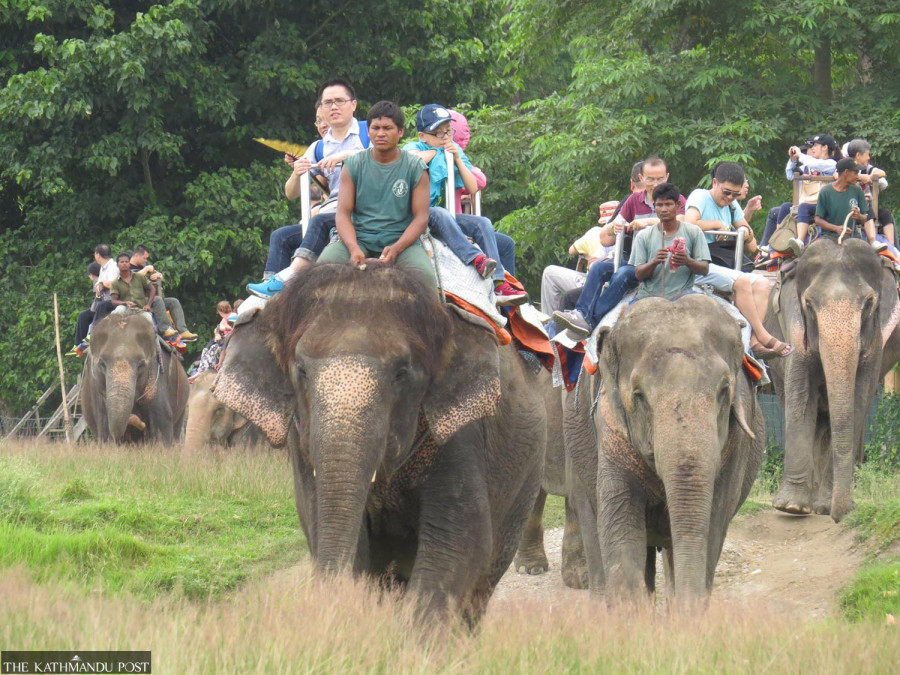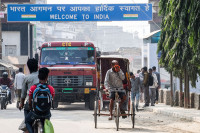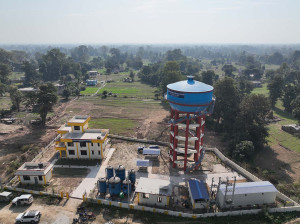Money
Botched road works threaten Chitwan’s wildlife tourism
Chitwan National Park reported a loss of 37,011 domestic visitors in the first six months of the current fiscal year.
Ramesh Kumar Paudel
Road construction activities in several areas have damaged Chitwan, which is renowned for its wildlife tourism. The number of Nepalis visiting the park has dropped sharply in recent months.
Nepal’s first national park, Chitwan National Park, welcomed more than 300,000 visitors in the last fiscal year, the highest number on record. However, based on the low volume of inquiries and bookings, entrepreneurs fear that the current fiscal year might be one of the worst.
In the first six months of the last fiscal year, 148,391 tourists visited Chitwan National Park. Of these, 90,114 were domestic visitors, and 43,425 foreigners. However, domestic tourists sharply declined during the first half of this fiscal year.
Abinash Thapa Magar, information officer at Chitwan National Park, reported that among the 110,345 tourists who visited the park in the review period, 53,103 were domestic. This indicates a loss of 37,011 domestic visitors.
The park maintains separate data for domestic, international, and SAARC tourists. The number of visitors from SAARC countries has also dropped, with only 10,850 tourists recorded in the half-year period. On the other hand, the number of international tourists has slightly improved, with 46,392 visitors—an increase of approximately 3,000 from last year.
“The road conditions are disastrous. Whether it’s the Butwal-Narayangadh or the Kathmandu-Chitwan road, none is in good condition. When major highways are in such a state, the number of tourists cannot keep up,” said Prem Shankar Mardiniya Tharu, president of the Nepal Homestay Federation.
Established in 1973, Chitwan Park is Nepal’s first national park. Known for its dense tropical jungle, the park offers jungle tours on jeeps, elephant backs, and canoe rides on crocodile-infested rivers. It has significantly boosted the tourism sector and played a crucial role in helping Nepal double its tiger population by 2022.
“Most tourists visit the national park to observe wildlife. In the past, factors like earthquakes and Covid-19 have caused fluctuations in visitor numbers,” said Mardiniya. “This time, the decline in tourist numbers, especially domestic visitors, is primarily due to road conditions. This has impacted homestays in particular.”
The park, with its rich biodiversity, has gained international recognition for conservation and has become a popular safari destination. However, it heavily relies on tourism revenue, and the livelihoods of hundreds of people depend on it. The Covid pandemic first dealt its severe blow to tourism of the decade, and the current situation adds to the challenges.
“I feel that promotional activities for tourism have stopped, both domestically and internationally. Even if the roads improve, a lack of promotional efforts will negatively impact tourism,” said Mardiniya. “Promotional activities need to be conducted across all platforms.”
Bishal Kumal, president of the Chitwan Golaghat Tourism Development Committee, emphasised the importance of exploring new tourism potential.
“Besides safaris in the national park, other tourism opportunities should be utilised,” said Kumal. “For instance, introducing water activities such as boating from Golaghat to Triveni, Devghat, and Sauraha could attract religious tourists.”
Golaghat is also an excellent location for viewing the sunset. “Including activities showcasing the traditional homes of Tharu, Kumal, and other ethnic communities in the tour itinerary could draw more tourists,” Kumal added. “However, this requires support and coordination from all three tiers of government.”
Patihani, located in Bharatpur Metropolitan City, is emerging as a promising tourism area, with new hotels and resorts opening steadily.
“I’ve heard tourists complaining about not seeing wild animals during their visits. Entrepreneurs have echoed these concerns,” said Bishnu Raj Mahato, ward chairman of Ward 22 in Bharatpur metropolis. “This could be due to poor management of jungles and ponds inside the park.”
Mahato also highlighted the abundance of wild animals in wetland community forests near the national park. “We should consider promoting these wetland areas to attract more visitors.”




 16.12°C Kathmandu
16.12°C Kathmandu1.jpg)













